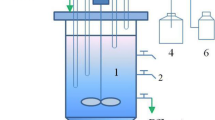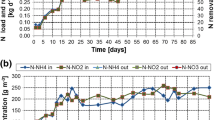Abstract
A sequencing batch reactor was employed to treat the acrylic fiber wastewater. The dissolved oxygen and mixed liquor suspended solids were 2–3 and 3,500–4,000 mg/L, respectively. The results showed ammonium oxidizing bacteria (AOB) had superior growth rate at high temperature than nitrite oxidizing bacteria (NOB). Partial nitrification could be obtained with the temperature of 28 °C. When the pH value was 8.5, the nitrite-N accumulation efficiency was 82 %. The combined inhibitions of high pH and free ammonium to NOB devoted to the nitrite-N buildup. Hydraulic retention time (HRT) was a key factor in partial nitrification control, and the optimal HRT was 20 h for nitrite-N buildup in acrylic fiber wastewater treatment. The ammonium oxidation was almost complete and the transformation from nitrite to nitrate could be avoided. AOB and NOB accounted for 2.9 and 4.7 %, respectively, corresponding to the pH of 7.0. When the pH was 8.5, they were 6.7 and 0.9 %, respectively. AOB dominated nitrifying bacteria, and NOB was actually washed out from the system.





Similar content being viewed by others
References
Amann RI, Krumholz L, Stahl DA (1990) Fluorescent-oligonucleotide probing of whole cells for determinative, phylogenetic, and environmental studies in microbiology. J Bacteriol 172:762–770
Antonio A, Jacek M, Krishna P (2012) Impact of aeration conditions on the removal of low concentrations of nitrogen in a tertiary partially aerated biological filter. Ecol Eng 44:44–52
APHA (1999) Standard methods for the examination of water and wastewater. American Public Health Association, Washington
Bae W, Baek S, Chung J, Lee Y (2001) Optimal operational factors for nitrite accumulation in batch reactors. Biodegradation 12:359–366
Banashri S, Ajit PA (2007) Partial nitrification—operational parameters and microorganisms involved. Rev Environ Sci Biotechnol 6:285–313
Carmen SD Rodrigues, Luis M Madeira, Rui AR Boaventura (2009) Treatment of textile effluent by chemical (Fenton’s reagent) and biological (sequencing batch reactor) oxidation. J Hazard Mater 172:1551–1559
Cheng SS, Chen YN, Wu KL, Chuang HP, Chen SD (2004) Study of a three-stage fluidized bed process treating acrylic synthetic-fiber manufacturing wastewater containing high-strength nitrogenous compounds. Water Sci Technol 49:113–119
Chu L, Wang J (2011) Nitrogen removal using biodegradable polymers as carbon source and biofilm carriers in a moving bed biofilm reactor. Chem Eng J 170:220–225
Chung J, Bae W, Lee YW, Rittmann BE (2007) Shortcut biological nitrogen removal in hybrid biofilm/suspended growth reactors. Process Biochem 42:320–328
Guo JH, Peng YZ, Wang SY, Zheng YN, Huang HJ, Ge SJ (2009a) Effective and robust partial nitrification to nitrite by real-time aeration duration control in an SBR treating domestic wastewater. Process Biochem 44(9):979–985
Guo J, Peng Y, Wang S, Zheng Y, Huang H, Wang Z (2009b) Long-term effect of dissolved oxygen on partial nitrification performance and microbial community structure. Bioresour Technol 100:2796–2802
Hellinga C, Schellen A, Mulder JW, van Loosdrecht MCM, Heijnen JJ (1998) The SHARON process: an innovative method for nitrogen removal from ammonium-rich waste water. Water Sci Technol 37(9):135–142
Ismail T, Sourour S, Faycal O (2011) Coupling short-time sequencing batch reactor and coagulation-settling process for co-treatment of landfill leachate with raw municipal wastewater. Arab J Geosci 18:189–197
Kim DJ, Lee DI, Keller J (2006) Effect of temperature and free ammonia on nitrification and nitrite accumulation in landfill leachate and analysis of its nitrifying bacterial community by FISH. Bioresour Technol 97(3):459–468
Lee KH, Kang BC, Lee JB (2006) Acrylic wastewater treatment and long-term operation using a membrane separation system. Desalination 191:169–177
Li J, Yu DS, Wang D (2011) Experimental test for high saline wastewater treatment in a submerged membrane bioreactor. Desalin Water Treat 36:171–177
Loy A, Horn M, Wagner M (2003) Probebase: an online resource for rRNA-targeted oligonucleotide probes. Nucleic Acid Res 31(1):514–516
Mobarry BK, Wagner M, Urbain V, Rittmann BE, Stahl DA (1996) Phylogenetic probes for analyzing abundance and spatial organization of nitrifying bacteria. Appl Environ Microb 62(6):2156–2162
Park S, Bae W, Chung J, Baek SC (2007) Empirical model of the pH dependence of the maximum specific nitrification rate. Process Biochem 42(12):1671–1676
Park S, Bae W, Rittmann BE (2010) Operational boundaries for nitrite accumulation in nitrification based on minimum/maximum substrate concentrations that include effects of oxygen limitation, pH, and free ammonia and free nitrous acid inhibition. Environ Sci Technol 44(1):335–342
Peng Y, Zhang S, Zeng W, Zheng S, Mino T, Satoh H (2008) Organic removal by denitrification and methanogenesis and nitrogen removal by nitritation from landfill leachate. Water Res 42(4–5):883–892
Sarah P, Hendrikus JL, Willy V (2002) Origin causes and effects of increased nitrite concentrations in aquatic environments. Rev Environ Sci Biotechnol 1(2):115–141
Sirianuntapiboon S, Chairattanawan K, Jungphungsukpanich S (2006) Some properties of a sequencing batch reactor system for removal of vat dyes. Bioresour Technol 97:1243–1252
Tantak NP, Chaudhari S (2006) Degradation of azo dyes by sequencing Fenton’s oxidation and biological treatment. J Hazard Mater 136:698–705
Tchobanoglous G, Burton FL, Stensel HD (2003) Wastewater engineering treatment and reuse, 4th edn. McGraw-Hill, New York
Turk O, Mavinic DS (1989) Maintaining nitrite buildup in a system acclimated to free ammonia. Water Res 23(11):1383–1388
van Hulle SWH, Volcke EIP, Teruel JL, Donckels B, van Loosdrecht MCM, Vanrolleghem PA (2007) Influence of temperature and pH on the kinetics of the Sharon nitritation process. J Chem Technol Biotechnol 82(5):471–480
Yang S, Yang F (2011) Nitrogen removal via short-cut simultaneous nitrification and denitrification in an intermittently aerated moving bed membrane bioreactor. J Hazard Mater 195:318–323
Yang SF, Liu QS, Tay JH, Liu Y (2004) Growth kinetics of aerobic granules developed in sequencing batch reactors. Lett Appl Microbiol 38:106–112
Yang Q, Peng YZ, Liu XH, Zeng W, Mino T, Satoh H (2007) Nitrogen removal via nitrite from municipal wastewater at low temperatures using real-time control to optimize nitrifying communities. Environ Sci Technol 41(23):8159–8164
Young SN, Chang HL, Tae KL, Song WL, Young SP, You KO, Sung HP, Seung KS (2005) Photocatalytic decomposition of nonbiodegradable substances in wastewater from an acrylic fiber manufacturing process. Korean J Chem Eng 22:246–249
Zhang Y, Zhao J, Gu G (2003) Biodegradation kinetic of organic compounds of acrylic fiber wastewater in biofilm. J Environ Sci Chin 15:757–761
Zhang Y, Zhou J, Zhang J, Yuan S (2009) An innovative membrane bioreactor and packed-bed biofilm reactor combined system for shortcut nitrification-denitrification. J Environ Sci Chin 21:568–574
Zhu GB, Peng YZ, Li BK, Guo JH, Yang Q, Wang SY (2008) Biological removal of nitrogen from wastewater. Rev Environ Contam Toxicol 192:159–195
Acknowledgment
The work was supported by the National Natural Scientific Foundation (No. 51078191 and No. 51278258).
Author information
Authors and Affiliations
Corresponding author
Rights and permissions
About this article
Cite this article
Li, J., Yu, D. & Zhang, P. Partial nitrification in a sequencing batch reactor treating acrylic fiber wastewater. Biodegradation 24, 427–435 (2013). https://doi.org/10.1007/s10532-012-9599-9
Received:
Accepted:
Published:
Issue Date:
DOI: https://doi.org/10.1007/s10532-012-9599-9




